Last Updated on 25 Aug 2025
The iGaming Fraud Hierarchy: From Signals to Evidence and Action
Share in
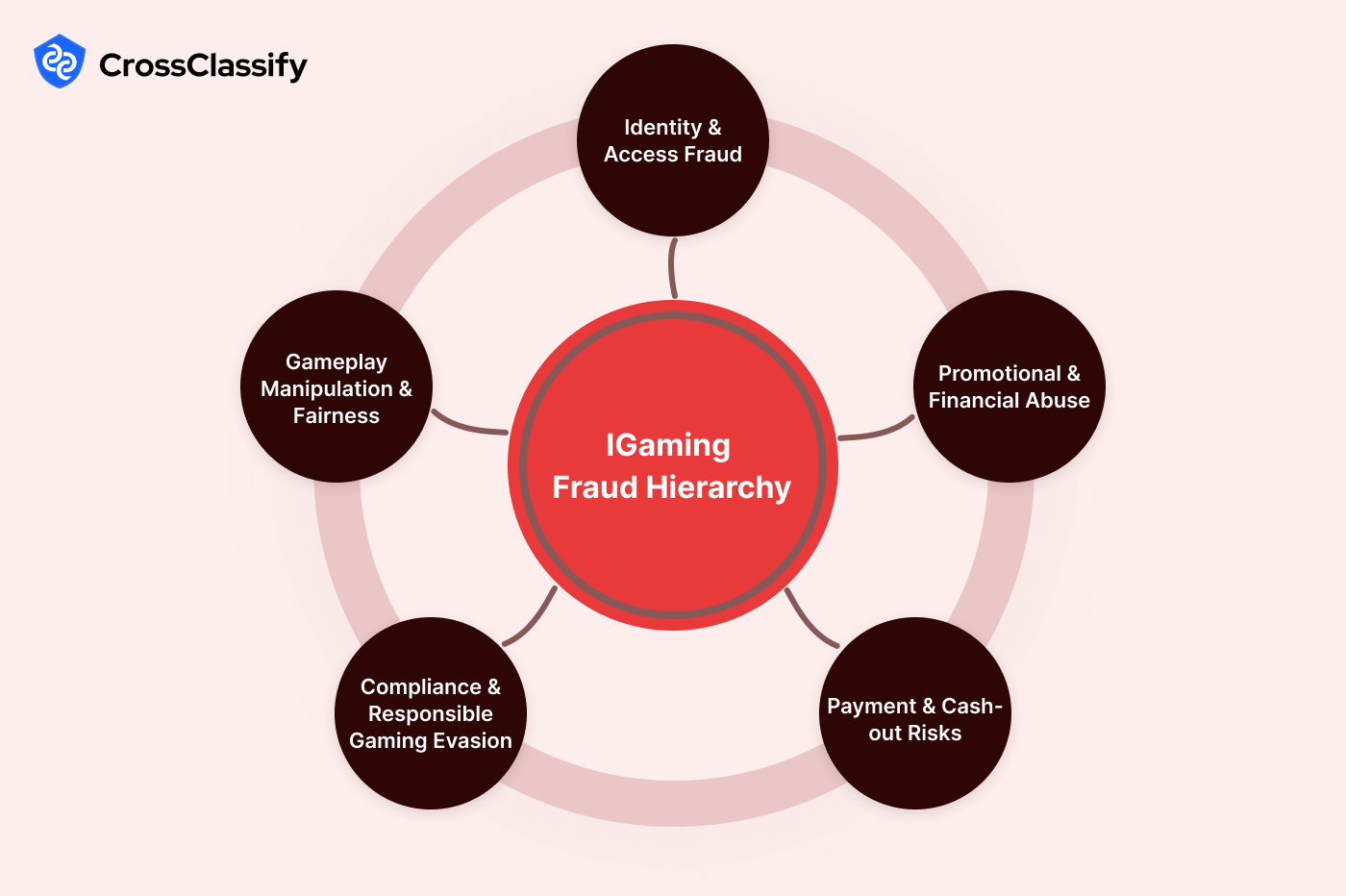
Introduction
Modern iGaming moves in real time across web, mobile, live casino streams, and partner payment rails. The same speed that delights players also gives bot operators, bonus farmers, colluders, and mule networks many angles. What wins is an AI powered iGaming fraud detection platform that converts identity, device, behavior, gameplay, affiliate, and payment signals into evidence backed decisions inside the session. This guide presents a practical hierarchy tailored to iGaming, from top level concerns to sub types and the exact evidence artifacts a team can show to product and audit stakeholders. Where helpful, we mention well reported cases such as public poker bot bans, collusion refunds on major rooms, and credential stuffing against sportsbook accounts, which confirm that these patterns are real and material.
Identity and Access Fraud in Player Accounts
High value accounts attract credential stuffing, help desk social engineering, and session token misuse. Operators feel the impact as instant wallet drains, rapid limit changes, or phishing driven resets that bypass MFA. Public reporting has covered sportsbook credential stuffing during peak sports weekends and reused passwords fueling account takeover. The goal in iGaming is to anchor every sensitive action to a persistent device and to human behavior that looks like the real player, then to raise friction only for the risky session. Teams that deploy device fingerprinting for iGaming and behavioral biometrics for iGaming lower false positives while keeping trusted players fast.
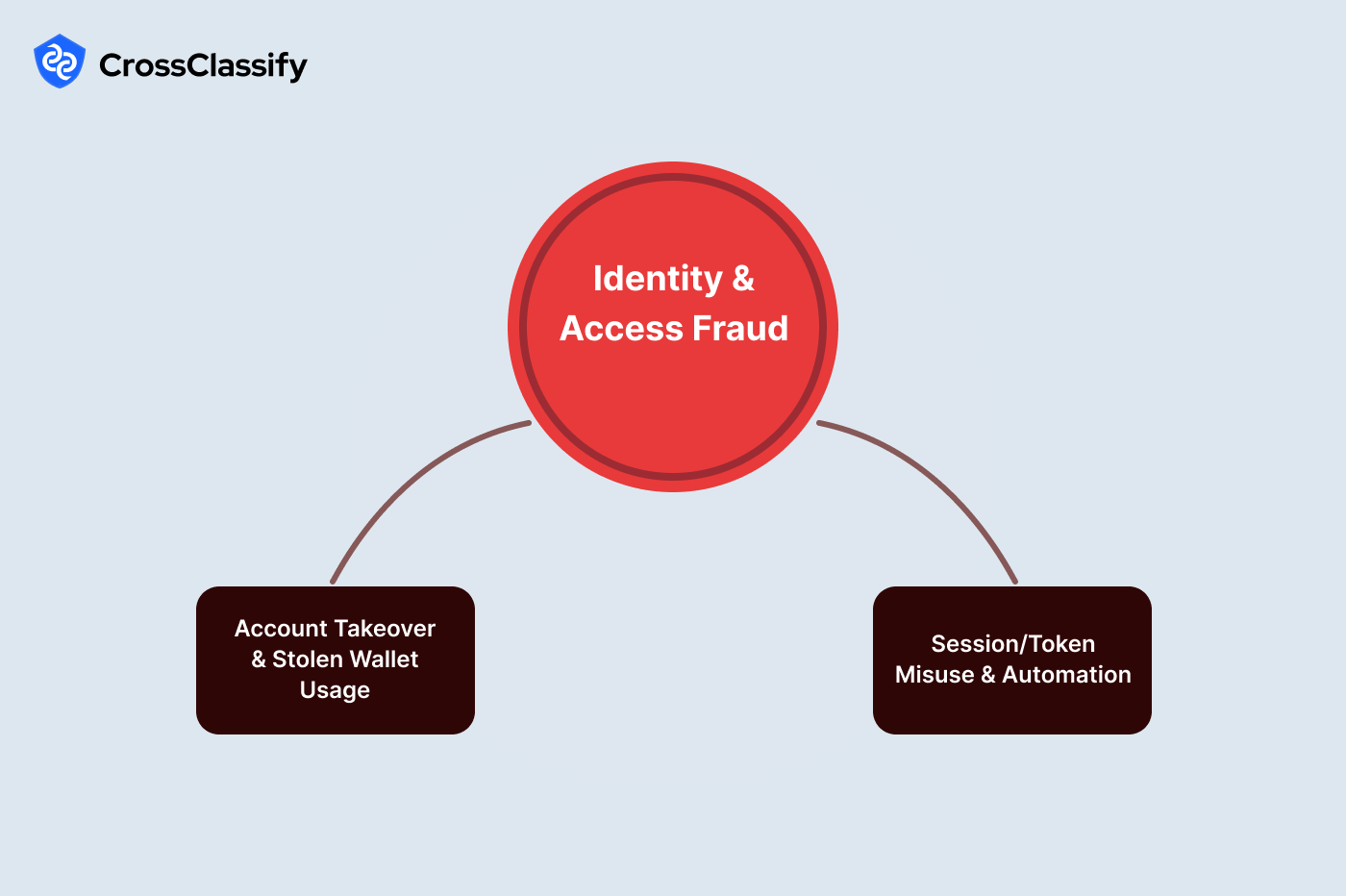

1. Account Takeover and Stolen Wallet Usage
Attackers land with leaked credentials, then push two moves: change limits and withdraw. Timing is decisive because the withdrawal often happens minutes after the first risky login.
- New login from unfamiliar region or device minutes before withdrawal: Evidence is a geo by hour heatmap. Clean traffic clusters in home geographies and standard hours. ATO staging lights up small time boxed cells from unfamiliar regions just before the withdrawal window, a pattern repeatedly seen in sportsbook incidents.
- Burst of failed logins that flips to success before a limit change: Evidence is a failures to success time series with a marker at the limit change. Long flat series are healthy. A tight spike that converts to one success right at the limit change is a classic credential stuffing conversion.
2. Session or Token Misuse and Automation
Token theft and headless scripts turn real accounts into machines. In iGaming this shows as fast bet bursts and traffic from hosting or VPN ASNs that do not match a player's history.
- Session token observed from hosting or VPN ASN: Evidence is a token to IP or ASN table. Healthy sessions come from residential or mobile networks. A known token that suddenly appears from a hosting ASN is a strong misuse signal that merits instant step up or rebind.
- Bets per second bursts above throttle policy: Evidence is a rate line against the throttle band. Human play wanders below the band. Short spikes above the limit reveal automation and are often tied to rapid market changes or latency windows in live betting.
Gameplay Manipulation and Fairness
Game integrity drives lifetime value and regulator trust. Bots and collusion concentrate in formats with repetitive actions and transparent opponent pools. Public cases in online poker have shown refund programs and bans triggered by collusion and bot detection teams. The playbook here relies on rhythm, co occurrence, and outcome symmetry rather than content of chat or cards. The result is a game integrity analytics capability for iGaming that surfaces evidence in minutes.
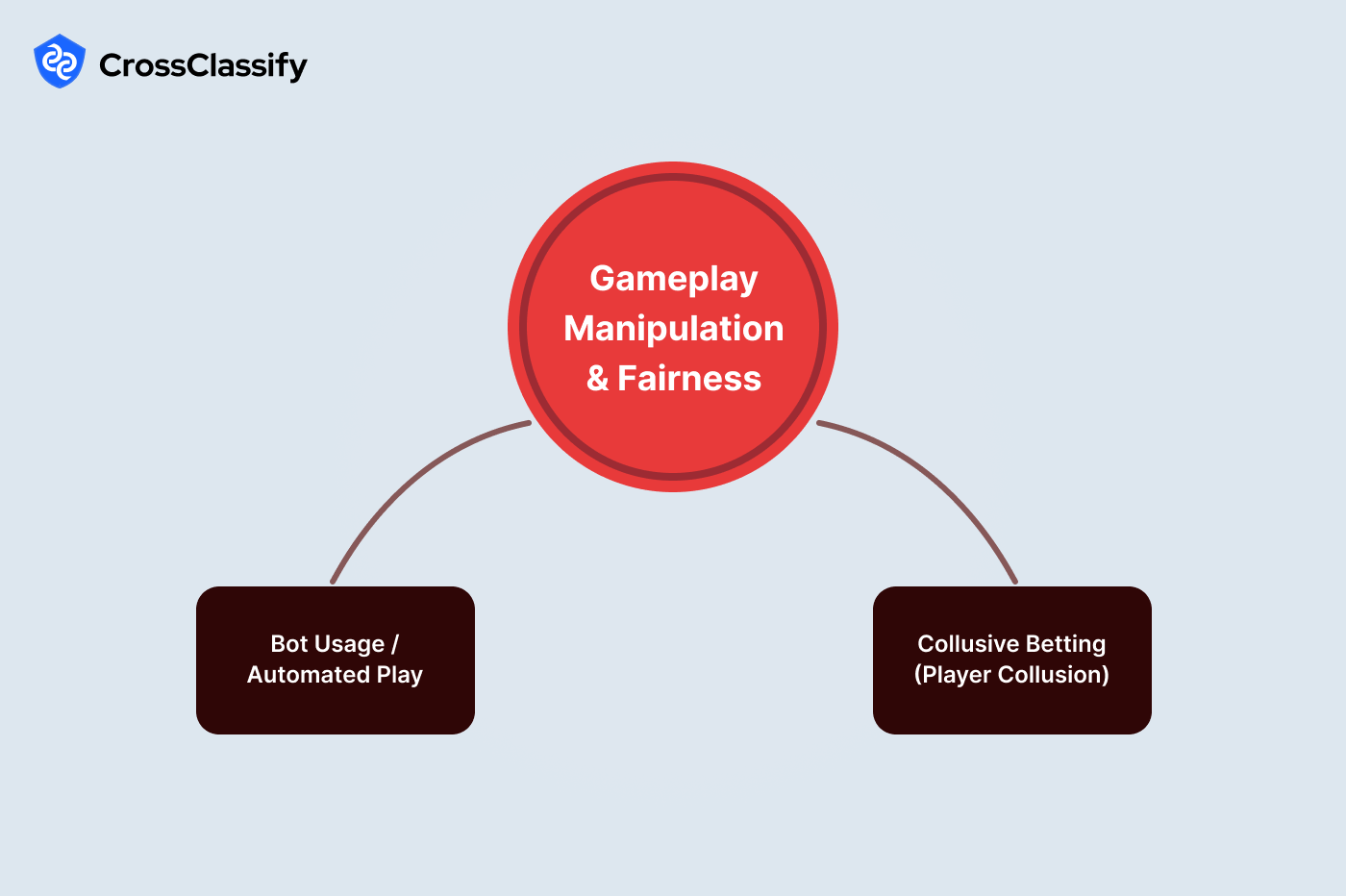

1. Bot Usage and Automated Play
Bots mimic perfect timing, zero fatigue, and consistent cursor travel. The fastest proof uses variance and session shape.
- Very tight reaction time variance: Evidence is a reaction time distribution. Human players show broad spread due to attention and context. A narrow peak at a single latency value is a machine signature and frequently aligns with other automation hints.
- Twenty four seven nonstop gameplay sessions: Evidence is a session duration histogram. Healthy ecosystems show short and medium sessions with natural breaks. A heavy tail near maximum lengths indicates scripted logins that rotate tables without rest.
2. Collusive Betting and Player Collusion
Colluders meet at the same tables, coordinate folds and checks, and engineer asymmetric outcomes. Well known poker platforms have published that they refund victims when analysis proves these patterns.
- Frequent co occurrence of the same player pairs at tables: Evidence is a co occurrence heatmap. Diffuse matrices are healthy. Hot cells that repeat reveal coordination and make a compelling artifact for case review.
- Abnormal win or loss ratios between recurring pairs: Evidence is a pair win loss scatter. Points near the diagonal are normal. Outliers far from parity, especially when combined with co occurrence, are consistent with chip dumping or soft play.
Promotional and Financial Abuse
Sign up promos, deposit matches, and affiliate payouts are prime targets. The abuse is organized, from device farms to disposable domain campaigns. Reputable rooms have battled promo drains for years and adjust program terms only after large losses. Cross functional evidence that merges device, traffic depth, and payout timing gives operations a faster containment option. This is where an iGaming bonus abuse prevention platform pays for itself.
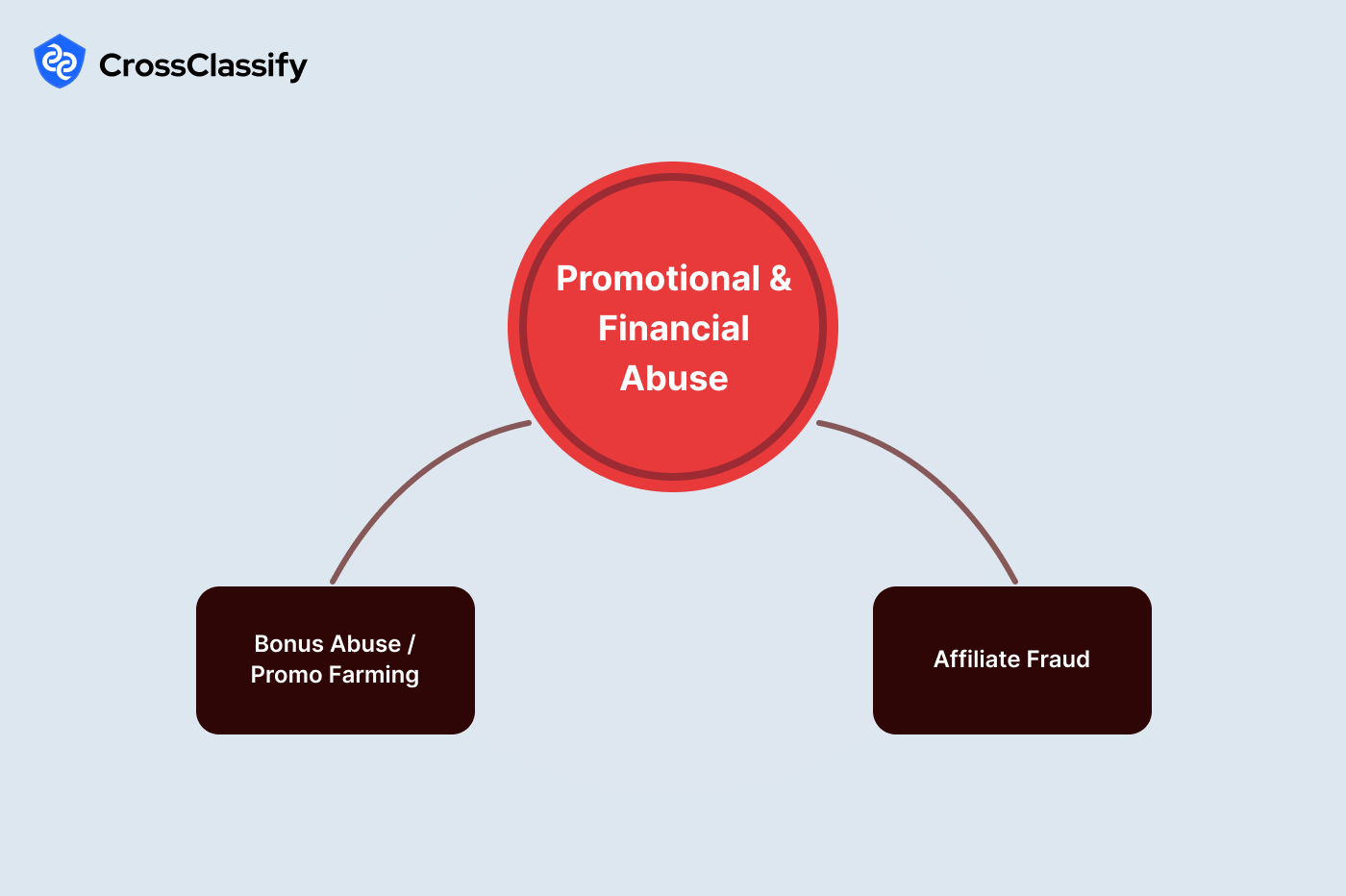

1. Bonus Abuse and Promo Farming
Farmers create many accounts on a small device pool and hit bonus endpoints directly.
- Many sign ups from the same device cluster: Evidence is a signups by device cluster bar chart. Even distribution is a pass. A single bar that towers over peers indicates a farm and justifies device level throttles.
- Zero depth sessions that jump straight to bonus endpoints: Evidence is a session depth histogram. Normal users browse rules and lobby pages before claiming. A surge in the zero depth bin signals scripted bonus harvesting.
2. Affiliate Fraud
Bad affiliates use very young or disposable domains and push players who instantly cash out after the minimum activity to earn payouts.
- Sign ups skew to very young or disposable email domains: Evidence is a domain age dashboard. Mature providers dominate healthy cohorts. Tall bars in the youngest buckets indicate burner registrations.
- Immediate withdrawals after initial deposit or bonus: Evidence is a minutes from deposit to withdrawal distribution. Genuine play produces longer intervals. A spike at very short intervals exposes mining of promo value.
Compliance and Responsible Gaming Evasion
Operators must enforce self exclusion, age, and geography controls. Evasion strategies include fresh accounts on the same device, VPN access, and falsified dates of birth. Regulators expect evidence of enforcement and proactive detection. A compliance analytics program for iGaming that attaches device and timing proof to each action shortens investigations and improves outcomes.
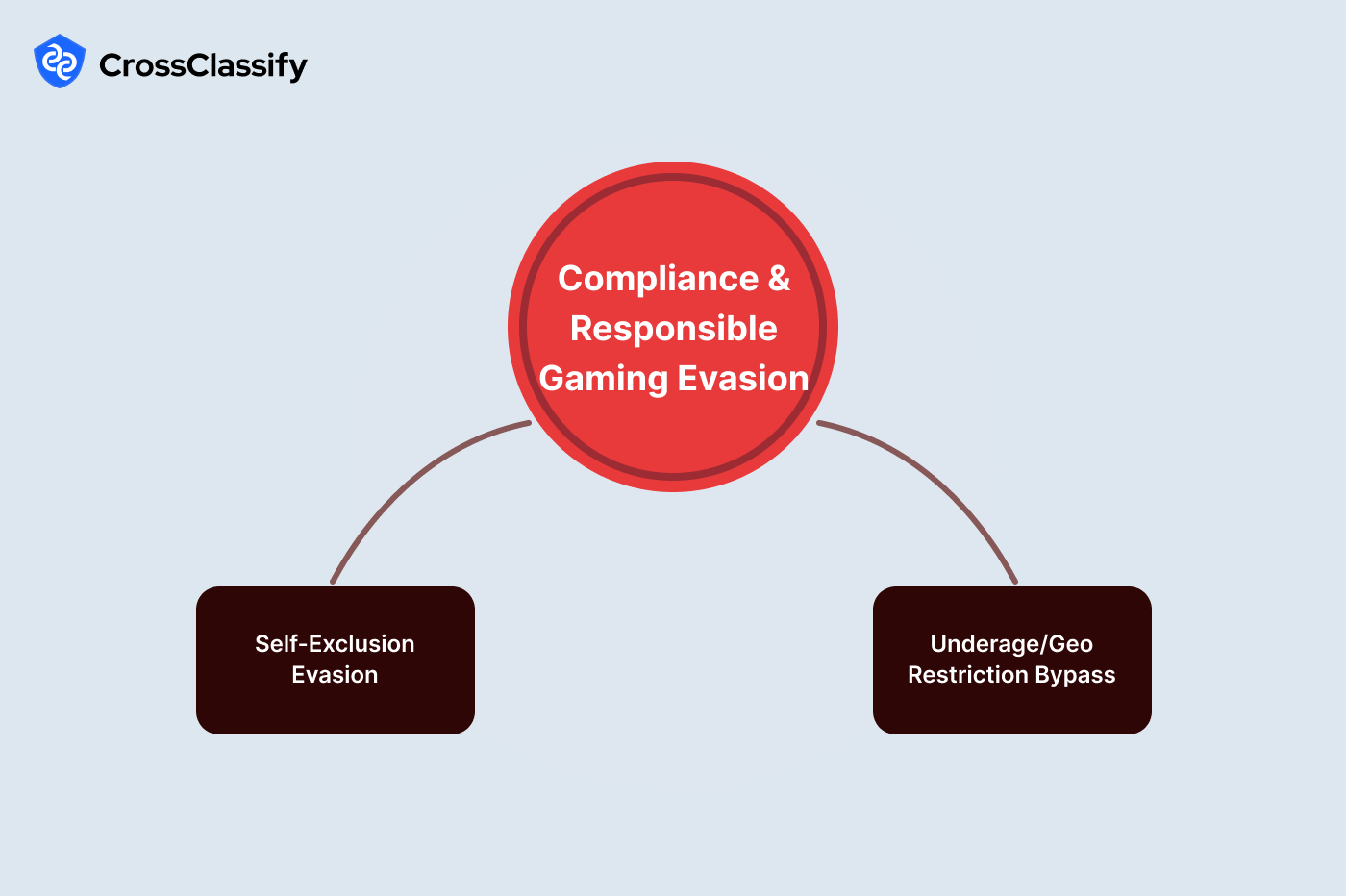

1. Self Exclusion Evasion
After exclusion, some actors try again with the same device or within minutes of the event.
- Device reused to create new accounts after self exclusion: Evidence is a device reuse table. The absence of repeats is the desired state. Reappearance within a short window is a clear breach and supports immediate blocks.
- New registrations cluster right after exclusion events: Evidence is a timeline that overlays exclusions and registrations. Uncorrelated lines are healthy. Synchronized peaks near the event mark require targeted holds.
2. Underage or Geo Restriction Bypass
VPNs and hosting ASNs are the modern answer to geo fences. Age evasion shows up as odd distribution shapes.
- Hosting or VPN ASNs dominate login traffic: Evidence is an ASN bar chart. Residential and mobile networks should lead. A tall hosting bar signals evasion and requires step up.
- Declared ages cluster below legal threshold: Evidence is an age histogram with a legal line. Mass to the right is normal. A visible bar to the left indicates intake control gaps.
Payment and Cash Out Risks
Card testing, friendly disputes, and mule cash outs silently tax margins. Public chargeback waves on peak calendars and payments to shared beneficiaries are common. A payment risk management stack for iGaming that binds deposits and withdrawals to device and network fingerprints gives finance the lift it needs without heavy friction.
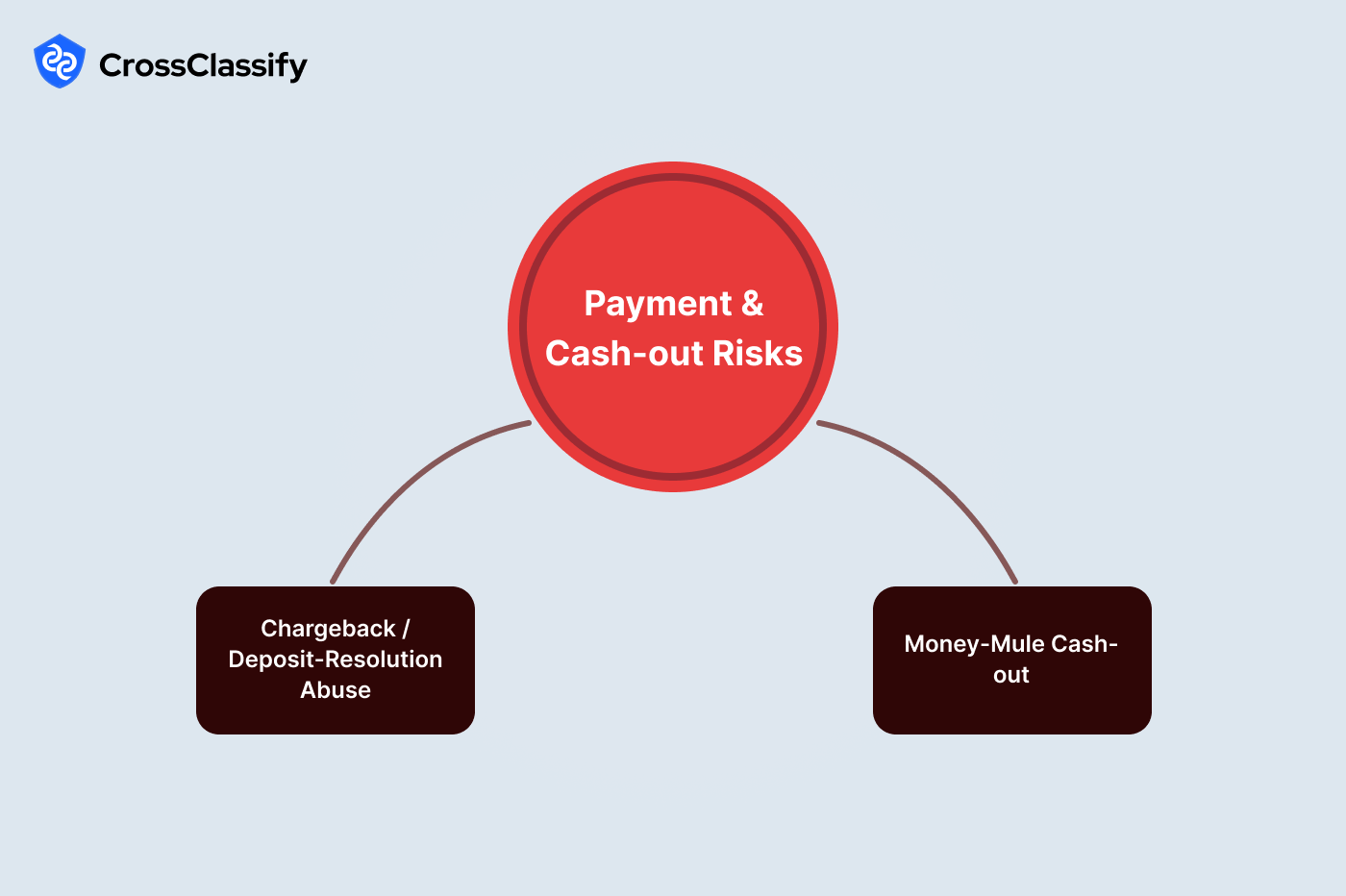

1. Chargeback and Deposit Resolution Abuse
When disputes detach from settled volume, friendly fraud or abuse is in motion.
- Chargebacks rising while settled volume is flat: Evidence is a dual line chart. Proportional movement is healthy. Divergence shows abusive dispute tactics and supports segment specific friction.
- Repeating micro authorization retry waves: Evidence is a retry trend line. Even cadence is normal. Periodic spikes reveal card testing and should trigger BIN or velocity controls.
2. Money Mule Cash Out
Mule networks aggregate winnings from many accounts to one beneficiary, especially after promo windows.
- Many accounts withdraw to the same bank or e wallet: Evidence is an accounts to beneficiary network. One to one edges are healthy. A star shaped hub identifies mule routing and is strong justification for a payout hold.
- Withdrawal bursts immediately after bonus claim windows: Evidence is a velocity timeline. Smooth drift is normal. A burst aligned to the bonus marker confirms farm to cash behavior.
Signals and Evidence, in one view
Each signal above is paired with a clear artifact. Use diagrams, dashboards, tables, graphs, and networks so reviewers can see the pattern without extra explanation. For quick reference, the iGaming solution page summarizes how CrossClassify operationalizes device, behavior, and risk scoring in the session.
How CrossClassify Delivers Evidence-Backed Control
CrossClassify operates as an AI powered iGaming fraud detection platform that fuses identity, device fingerprinting for iGaming, behavioral biometrics for iGaming, gameplay telemetry, affiliate metadata, and deposit and withdrawal events into a single, continuously refreshed risk state for each user, device, and session. Risk is not checked only at login. The score is recomputed at every sensitive step: limit increase, bonus claim, payment method add, KYC update, withdrawal request, live bet, affiliate conversion, and support assisted changes. Each decision is tied to hard evidence so risk, product, finance, and compliance teams can act with confidence.
Device binding that survives obfuscation.CrossClassify assigns a privacy-preserving device identity that persists through private browsing, cookie clears, and many VPN scenarios. Signals include network and TLS attributes, sensor consistency, virtual machine hints, and environment attestation on mobile. The approach and its limits are explained in "How Does Fingerprinting Work?" and "Device Fingerprinting".
Behavior models that keep trusted players fast. The platform learns keystroke cadence, field to field dwell and flight times, cursor travel, scroll rhythm, copy and paste patterns, and navigation sequences that are characteristic of real players rather than scripts. When a session matches the enrolled template, gameplay remains smooth with no extra prompts; when rhythm diverges at the moment of risk, the score climbs. Background and design choices appear in "Behavioral Biometrics".
Continuous adaptive risk in the flow. Signals are evaluated together through a session aware policy engine. When risk crosses a threshold, controls are applied at the exact step where harm would occur. Typical actions include:
Evidence that is ready for audit and support. Every automated decision carries an artifact that proves why the call was made: a geo by hour heatmap for risky logins, a failures to success timeline near a limit change, a device to account network for multi account farms, a domain age dashboard for affiliate quality, or a deposit to withdrawal timing graph. These diagram, dashboard, table, graph, and network objects are generated from the same features the model used, which shortens investigations and improves regulator conversations.
Program governance that scales. CrossClassify ships with change control, versioned policies, and KPI tracking so fraud leaders can manage risk without harming acquisition. Teams review false positive and false negative cohorts, run holdout tests on new rules, and export case evidence to SIEM or data platforms. Recommended governance practices and metrics are summarized in "Fraud Risk Management".
Deployment built for production iGaming. Web and mobile SDKs stream device and behavior signals with minimal overhead. Server side connectors ingest gameplay and payment events. Decision APIs return in milliseconds so checkout, live betting, and cash out flows remain fast. Privacy is preserved through hashing and configurable retention that aligns with regional rules and operator policy.
The outcome is clear. Operators gain precise, session level control that blocks account takeover, botting, promo abuse, collusion, and mule cash outs while keeping genuine players moving quickly. Every action is evidence backed, every policy is measurable, and the system learns from investigator feedback so protection and conversion rise together.
Device binding that survives obfuscation.CrossClassify assigns a privacy-preserving device identity that persists through private browsing, cookie clears, and many VPN scenarios. Signals include network and TLS attributes, sensor consistency, virtual machine hints, and environment attestation on mobile. The approach and its limits are explained in "How Does Fingerprinting Work?" and "Device Fingerprinting".
Behavior models that keep trusted players fast. The platform learns keystroke cadence, field to field dwell and flight times, cursor travel, scroll rhythm, copy and paste patterns, and navigation sequences that are characteristic of real players rather than scripts. When a session matches the enrolled template, gameplay remains smooth with no extra prompts; when rhythm diverges at the moment of risk, the score climbs. Background and design choices appear in "Behavioral Biometrics".
Continuous adaptive risk in the flow. Signals are evaluated together through a session aware policy engine. When risk crosses a threshold, controls are applied at the exact step where harm would occur. Typical actions include:
- Step up authentication before a wallet edit or a high value cash out.
- Payout hold with beneficiary revalidation when a bank change is closely followed by a withdrawal request.
- Edit lock and short cooldown after contact changes that resemble help desk social engineering.
- Bet throttle or session rebind when rate limits or token to ASN mismatches indicate automation.
- Bonus eligibility block when device clusters and zero depth browsing suggest promo farming.
Evidence that is ready for audit and support. Every automated decision carries an artifact that proves why the call was made: a geo by hour heatmap for risky logins, a failures to success timeline near a limit change, a device to account network for multi account farms, a domain age dashboard for affiliate quality, or a deposit to withdrawal timing graph. These diagram, dashboard, table, graph, and network objects are generated from the same features the model used, which shortens investigations and improves regulator conversations.
Program governance that scales. CrossClassify ships with change control, versioned policies, and KPI tracking so fraud leaders can manage risk without harming acquisition. Teams review false positive and false negative cohorts, run holdout tests on new rules, and export case evidence to SIEM or data platforms. Recommended governance practices and metrics are summarized in "Fraud Risk Management".
Deployment built for production iGaming. Web and mobile SDKs stream device and behavior signals with minimal overhead. Server side connectors ingest gameplay and payment events. Decision APIs return in milliseconds so checkout, live betting, and cash out flows remain fast. Privacy is preserved through hashing and configurable retention that aligns with regional rules and operator policy.
The outcome is clear. Operators gain precise, session level control that blocks account takeover, botting, promo abuse, collusion, and mule cash outs while keeping genuine players moving quickly. Every action is evidence backed, every policy is measurable, and the system learns from investigator feedback so protection and conversion rise together.
Explore CrossClassify today
Detect and prevent fraud in real time
Protect your accounts with AI-driven security
Try CrossClassify for FREE—3 months
Share in
Frequently asked questions
Most attacks show short spikes of failed logins that convert to a few successes in the same window. CrossClassify scores the failure to success conversion together with device drift and unfamiliar regions, then challenges only the risky session. The approach is explained in "The Anatomy of Account Takeover".
Promo farms reuse devices and disposable domains to create clusters. CrossClassify correlates device fingerprints and domain age to surface clusters on day one, then applies targeted holds. See "Avoid Fake Accounts" and the background on domain and device signals in "Device Fingerprinting".
Bots leave timing fingerprints that look nothing like humans. CrossClassify models reaction time variance and session shapes and flags machine like peaks in real time. Methodology is aligned with behavior features discussed in "Behavioral Biometrics".
Collusion shows as repeated co occurrence of the same pairs and asymmetric outcomes. CrossClassify produces the co occurrence heatmap and pair win loss scatter so investigators can act confidently. Practical evidence building is part of our iGaming guide "iGaming Cybersecurity".
Fraudsters change contact details then withdraw quickly. CrossClassify detects tight coupling of edit to withdrawal and pauses the payout until the session rebinds to a trusted device. The sequencing and just in time control pattern is described in "Continuous Adaptive Risk and Trust Assessment".
Healthy programs keep disputes proportional to settled volume. CrossClassify monitors the ratio trend and links disputed orders back to devices and cohorts so you can add friction only to the sources that drive the spike. Context for fraud economics appears in "Fraud Risk Management".
Yes, ASN class and device persistence make the difference clear. CrossClassify maps session tokens to ASN categories and rejects or steps up only when hosting traffic appears with new devices. Technical background on persistent device binding is at "How Does Fingerprinting Work?".
Zero depth sessions hit promo endpoints without browsing. CrossClassify scores session depth and user agent quality, then throttles or blocks when patterns spike while preserving real users. The layered detection idea is covered in "Uncover the Threats WAF and MFA Miss".
Rely on distribution analytics and device reuse, not only self reported dates. CrossClassify highlights left side age spikes and detects device reuse across accounts to trigger targeted verification. See onboarding risk concepts in "New Account Fraud" and "The Growing Threat of Account Opening Fraud".
Young domains and instant cash outs are the fastest indicators. CrossClassify ships domain age dashboards and deposit to withdrawal timing evidence so your team can enforce terms with data. Program ideas are in "Fraud Risk Management".
Yes, look for tokens from new ASNs and rate spikes that climb above policy. CrossClassify correlates token to ASN tables with bet per second lines and introduces a rebind flow only for those sessions. Related concepts are discussed in "Uncover the Threats WAF and MFA Miss".
Synthetics reuse documents and push high velocity registrations. CrossClassify detects document hash reuse and device clusters while keeping instant signup for clean cohorts. Strategy is outlined in "Avoid Fake Accounts" and deeper background in "The Growing Threat of Account Opening Fraud".

Let’s Get Started
Discover how to secure your app against fraud using CrossClassify
No credit card required
